Current Practices, Trends, and Emerging Roles in L&D Report
VerifiedAdded on 2022/12/22
|19
|4642
|91
Report
AI Summary
This report provides a comprehensive overview of Learning and Development (L&D), examining current practices, trends, and emerging roles within organizations. The report begins by defining L&D and its role in improving individual and group performance, aligning with organizational goals. It then explores current practices such as performance improvement, talent management, and the alignment of company and L&D goals. The report also discusses the impact of social learning and gamification on L&D initiatives. Furthermore, the report identifies the critical knowledge, skills, and behaviors required by L&D professionals, including people practices, data analytics, digital working, and change management. The report also delves into project and self-management techniques, such as quality management, critical thinking, cost management, communication, and problem-solving. The report provides a practical application of these techniques through the author's experience managing a project. Overall, the report offers valuable insights into the evolving landscape of L&D and the essential skills needed to succeed in the field.
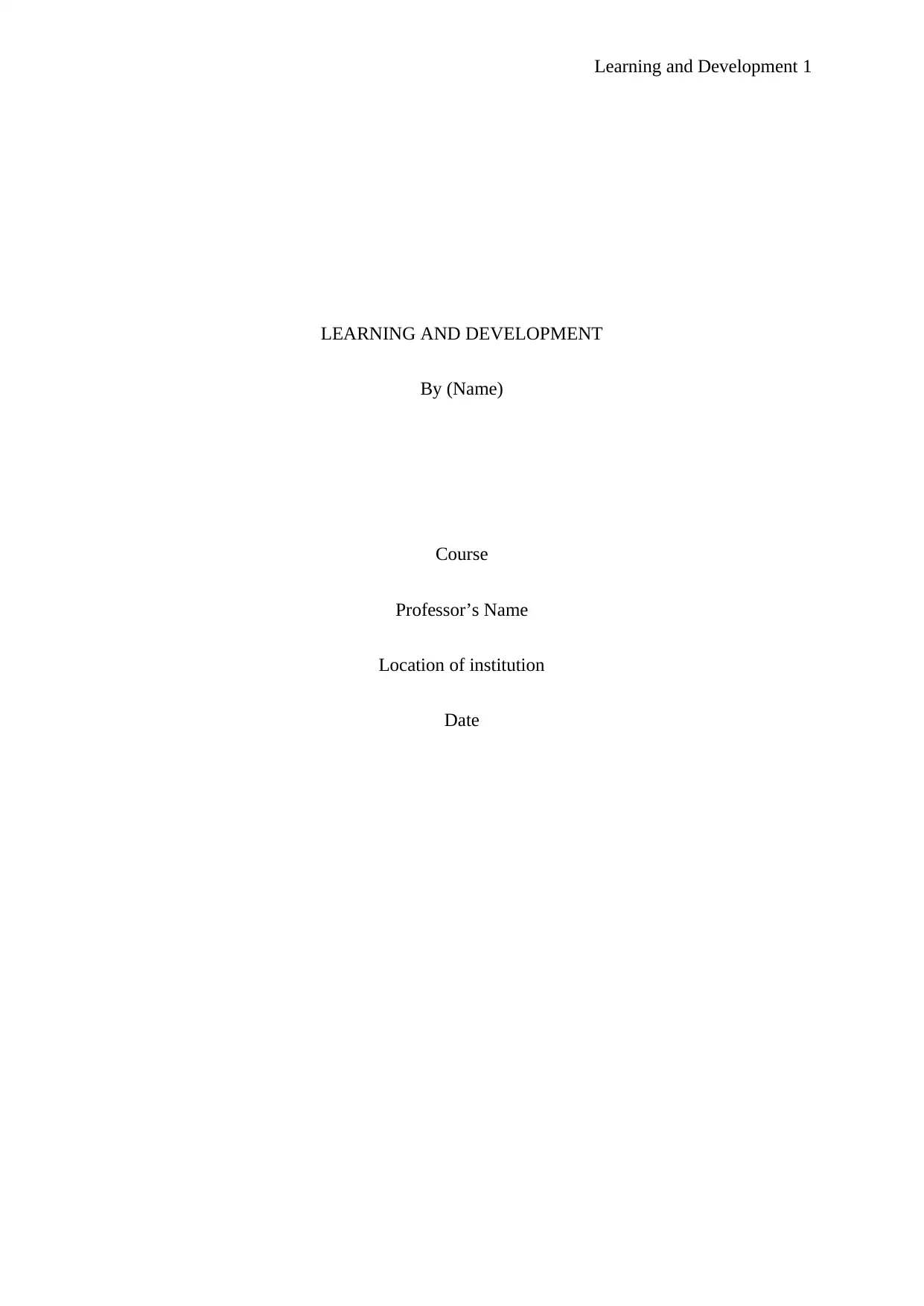
Learning and Development 1
LEARNING AND DEVELOPMENT
By (Name)
Course
Professor’s Name
Location of institution
Date
LEARNING AND DEVELOPMENT
By (Name)
Course
Professor’s Name
Location of institution
Date
Paraphrase This Document
Need a fresh take? Get an instant paraphrase of this document with our AI Paraphraser
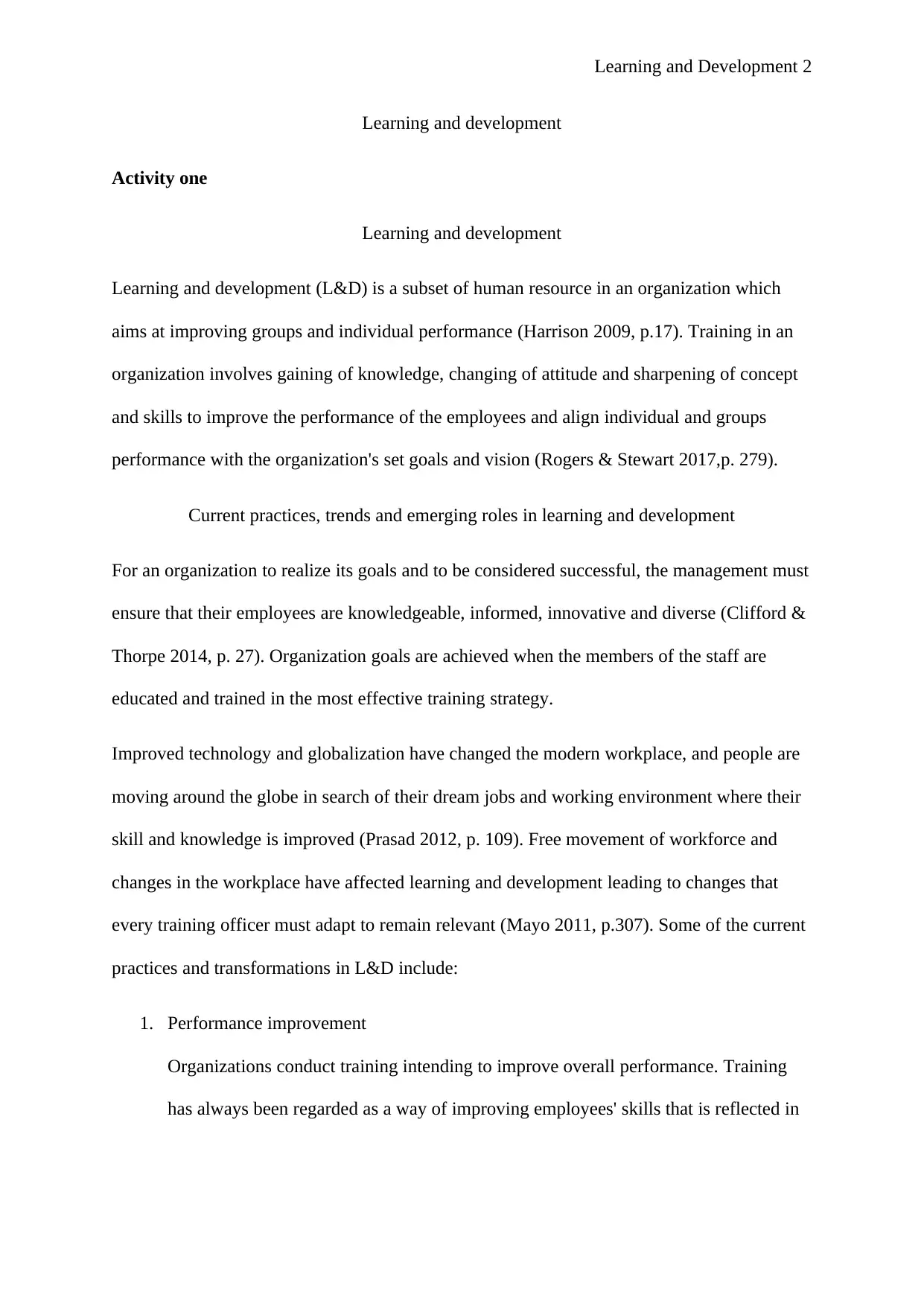
Learning and Development 2
Learning and development
Activity one
Learning and development
Learning and development (L&D) is a subset of human resource in an organization which
aims at improving groups and individual performance (Harrison 2009, p.17). Training in an
organization involves gaining of knowledge, changing of attitude and sharpening of concept
and skills to improve the performance of the employees and align individual and groups
performance with the organization's set goals and vision (Rogers & Stewart 2017,p. 279).
Current practices, trends and emerging roles in learning and development
For an organization to realize its goals and to be considered successful, the management must
ensure that their employees are knowledgeable, informed, innovative and diverse (Clifford &
Thorpe 2014, p. 27). Organization goals are achieved when the members of the staff are
educated and trained in the most effective training strategy.
Improved technology and globalization have changed the modern workplace, and people are
moving around the globe in search of their dream jobs and working environment where their
skill and knowledge is improved (Prasad 2012, p. 109). Free movement of workforce and
changes in the workplace have affected learning and development leading to changes that
every training officer must adapt to remain relevant (Mayo 2011, p.307). Some of the current
practices and transformations in L&D include:
1. Performance improvement
Organizations conduct training intending to improve overall performance. Training
has always been regarded as a way of improving employees' skills that is reflected in
Learning and development
Activity one
Learning and development
Learning and development (L&D) is a subset of human resource in an organization which
aims at improving groups and individual performance (Harrison 2009, p.17). Training in an
organization involves gaining of knowledge, changing of attitude and sharpening of concept
and skills to improve the performance of the employees and align individual and groups
performance with the organization's set goals and vision (Rogers & Stewart 2017,p. 279).
Current practices, trends and emerging roles in learning and development
For an organization to realize its goals and to be considered successful, the management must
ensure that their employees are knowledgeable, informed, innovative and diverse (Clifford &
Thorpe 2014, p. 27). Organization goals are achieved when the members of the staff are
educated and trained in the most effective training strategy.
Improved technology and globalization have changed the modern workplace, and people are
moving around the globe in search of their dream jobs and working environment where their
skill and knowledge is improved (Prasad 2012, p. 109). Free movement of workforce and
changes in the workplace have affected learning and development leading to changes that
every training officer must adapt to remain relevant (Mayo 2011, p.307). Some of the current
practices and transformations in L&D include:
1. Performance improvement
Organizations conduct training intending to improve overall performance. Training
has always been regarded as a way of improving employees' skills that is reflected in
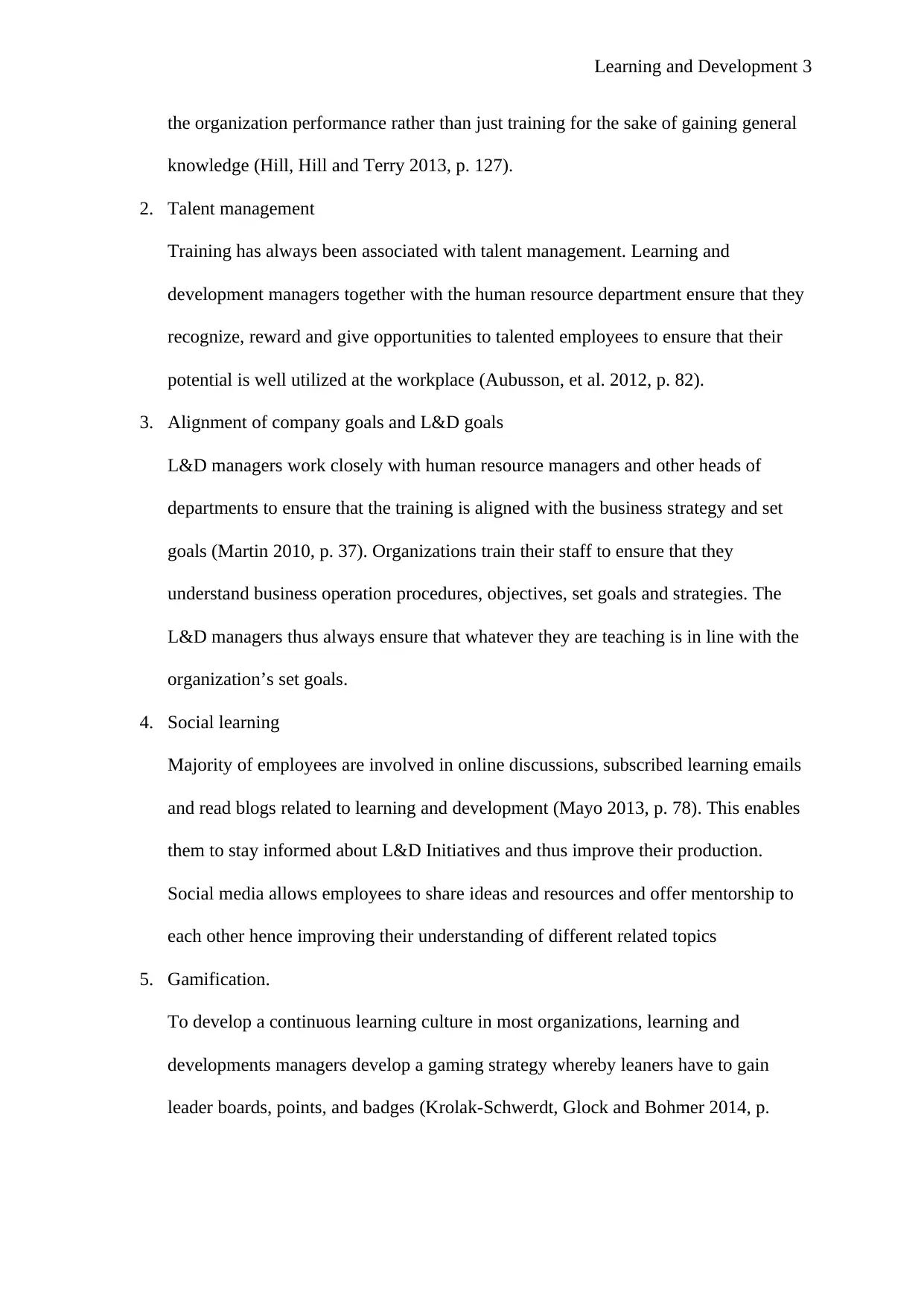
Learning and Development 3
the organization performance rather than just training for the sake of gaining general
knowledge (Hill, Hill and Terry 2013, p. 127).
2. Talent management
Training has always been associated with talent management. Learning and
development managers together with the human resource department ensure that they
recognize, reward and give opportunities to talented employees to ensure that their
potential is well utilized at the workplace (Aubusson, et al. 2012, p. 82).
3. Alignment of company goals and L&D goals
L&D managers work closely with human resource managers and other heads of
departments to ensure that the training is aligned with the business strategy and set
goals (Martin 2010, p. 37). Organizations train their staff to ensure that they
understand business operation procedures, objectives, set goals and strategies. The
L&D managers thus always ensure that whatever they are teaching is in line with the
organization’s set goals.
4. Social learning
Majority of employees are involved in online discussions, subscribed learning emails
and read blogs related to learning and development (Mayo 2013, p. 78). This enables
them to stay informed about L&D Initiatives and thus improve their production.
Social media allows employees to share ideas and resources and offer mentorship to
each other hence improving their understanding of different related topics
5. Gamification.
To develop a continuous learning culture in most organizations, learning and
developments managers develop a gaming strategy whereby leaners have to gain
leader boards, points, and badges (Krolak-Schwerdt, Glock and Bohmer 2014, p.
the organization performance rather than just training for the sake of gaining general
knowledge (Hill, Hill and Terry 2013, p. 127).
2. Talent management
Training has always been associated with talent management. Learning and
development managers together with the human resource department ensure that they
recognize, reward and give opportunities to talented employees to ensure that their
potential is well utilized at the workplace (Aubusson, et al. 2012, p. 82).
3. Alignment of company goals and L&D goals
L&D managers work closely with human resource managers and other heads of
departments to ensure that the training is aligned with the business strategy and set
goals (Martin 2010, p. 37). Organizations train their staff to ensure that they
understand business operation procedures, objectives, set goals and strategies. The
L&D managers thus always ensure that whatever they are teaching is in line with the
organization’s set goals.
4. Social learning
Majority of employees are involved in online discussions, subscribed learning emails
and read blogs related to learning and development (Mayo 2013, p. 78). This enables
them to stay informed about L&D Initiatives and thus improve their production.
Social media allows employees to share ideas and resources and offer mentorship to
each other hence improving their understanding of different related topics
5. Gamification.
To develop a continuous learning culture in most organizations, learning and
developments managers develop a gaming strategy whereby leaners have to gain
leader boards, points, and badges (Krolak-Schwerdt, Glock and Bohmer 2014, p.
⊘ This is a preview!⊘
Do you want full access?
Subscribe today to unlock all pages.

Trusted by 1+ million students worldwide
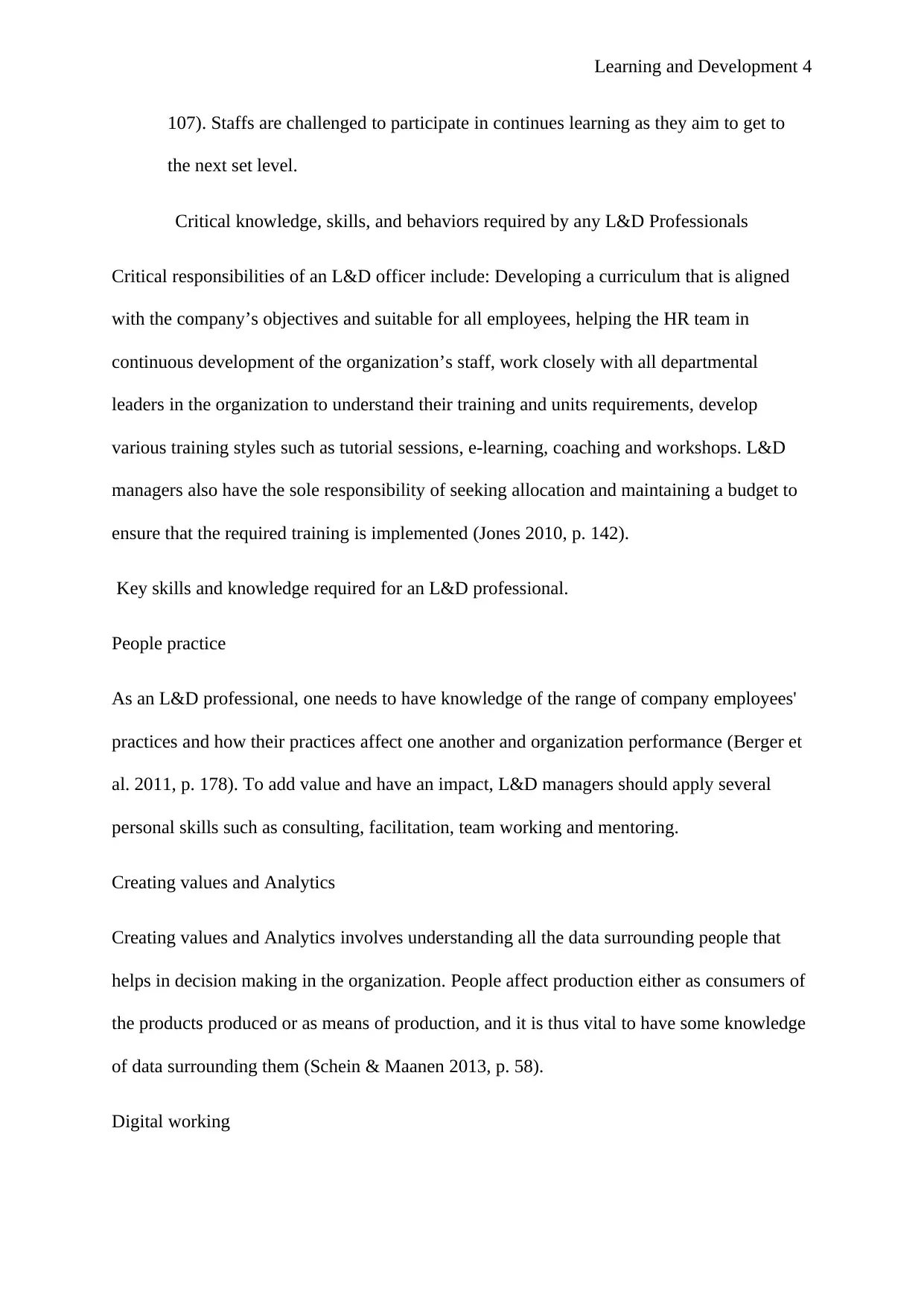
Learning and Development 4
107). Staffs are challenged to participate in continues learning as they aim to get to
the next set level.
Critical knowledge, skills, and behaviors required by any L&D Professionals
Critical responsibilities of an L&D officer include: Developing a curriculum that is aligned
with the company’s objectives and suitable for all employees, helping the HR team in
continuous development of the organization’s staff, work closely with all departmental
leaders in the organization to understand their training and units requirements, develop
various training styles such as tutorial sessions, e-learning, coaching and workshops. L&D
managers also have the sole responsibility of seeking allocation and maintaining a budget to
ensure that the required training is implemented (Jones 2010, p. 142).
Key skills and knowledge required for an L&D professional.
People practice
As an L&D professional, one needs to have knowledge of the range of company employees'
practices and how their practices affect one another and organization performance (Berger et
al. 2011, p. 178). To add value and have an impact, L&D managers should apply several
personal skills such as consulting, facilitation, team working and mentoring.
Creating values and Analytics
Creating values and Analytics involves understanding all the data surrounding people that
helps in decision making in the organization. People affect production either as consumers of
the products produced or as means of production, and it is thus vital to have some knowledge
of data surrounding them (Schein & Maanen 2013, p. 58).
Digital working
107). Staffs are challenged to participate in continues learning as they aim to get to
the next set level.
Critical knowledge, skills, and behaviors required by any L&D Professionals
Critical responsibilities of an L&D officer include: Developing a curriculum that is aligned
with the company’s objectives and suitable for all employees, helping the HR team in
continuous development of the organization’s staff, work closely with all departmental
leaders in the organization to understand their training and units requirements, develop
various training styles such as tutorial sessions, e-learning, coaching and workshops. L&D
managers also have the sole responsibility of seeking allocation and maintaining a budget to
ensure that the required training is implemented (Jones 2010, p. 142).
Key skills and knowledge required for an L&D professional.
People practice
As an L&D professional, one needs to have knowledge of the range of company employees'
practices and how their practices affect one another and organization performance (Berger et
al. 2011, p. 178). To add value and have an impact, L&D managers should apply several
personal skills such as consulting, facilitation, team working and mentoring.
Creating values and Analytics
Creating values and Analytics involves understanding all the data surrounding people that
helps in decision making in the organization. People affect production either as consumers of
the products produced or as means of production, and it is thus vital to have some knowledge
of data surrounding them (Schein & Maanen 2013, p. 58).
Digital working
Paraphrase This Document
Need a fresh take? Get an instant paraphrase of this document with our AI Paraphraser
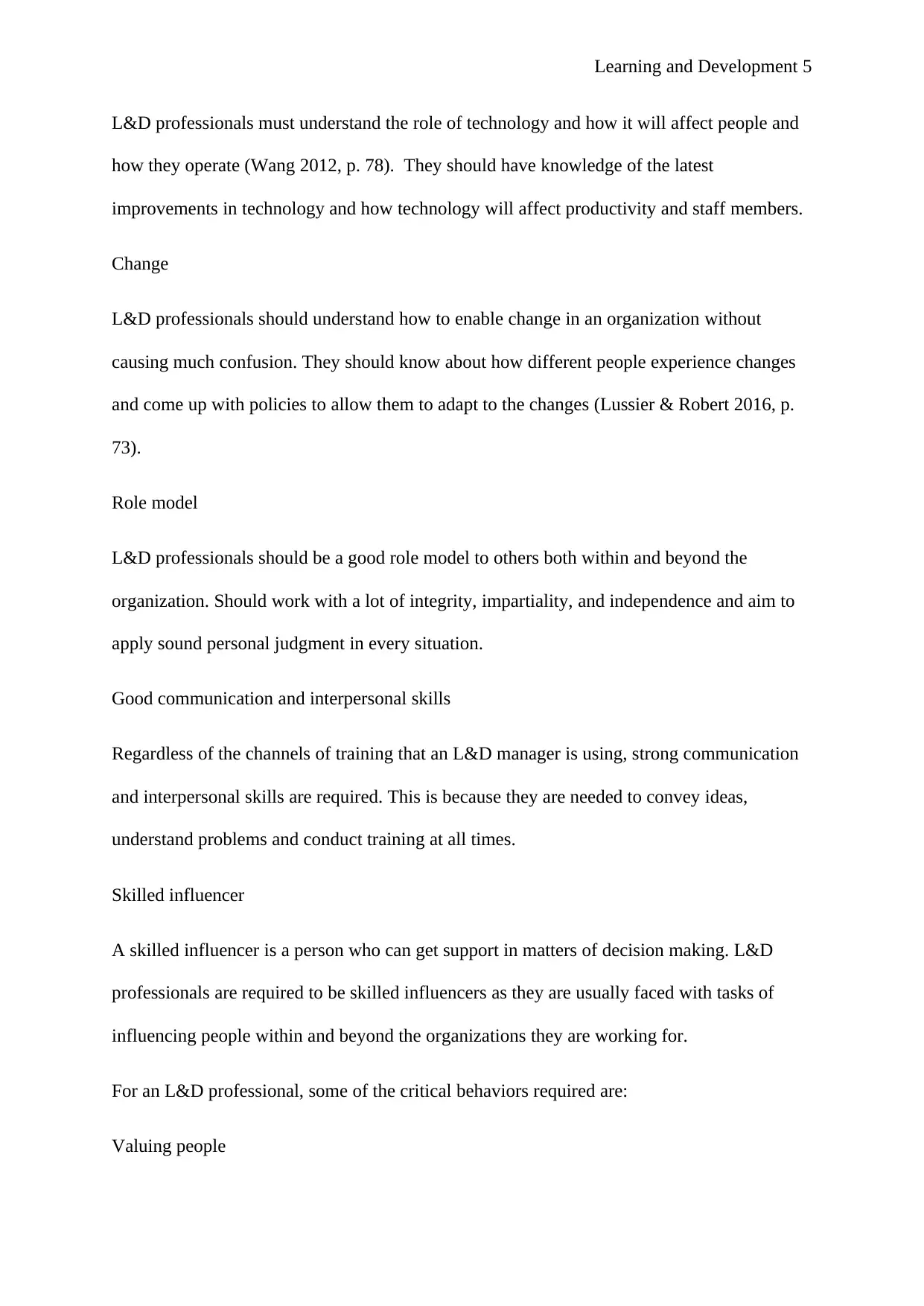
Learning and Development 5
L&D professionals must understand the role of technology and how it will affect people and
how they operate (Wang 2012, p. 78). They should have knowledge of the latest
improvements in technology and how technology will affect productivity and staff members.
Change
L&D professionals should understand how to enable change in an organization without
causing much confusion. They should know about how different people experience changes
and come up with policies to allow them to adapt to the changes (Lussier & Robert 2016, p.
73).
Role model
L&D professionals should be a good role model to others both within and beyond the
organization. Should work with a lot of integrity, impartiality, and independence and aim to
apply sound personal judgment in every situation.
Good communication and interpersonal skills
Regardless of the channels of training that an L&D manager is using, strong communication
and interpersonal skills are required. This is because they are needed to convey ideas,
understand problems and conduct training at all times.
Skilled influencer
A skilled influencer is a person who can get support in matters of decision making. L&D
professionals are required to be skilled influencers as they are usually faced with tasks of
influencing people within and beyond the organizations they are working for.
For an L&D professional, some of the critical behaviors required are:
Valuing people
L&D professionals must understand the role of technology and how it will affect people and
how they operate (Wang 2012, p. 78). They should have knowledge of the latest
improvements in technology and how technology will affect productivity and staff members.
Change
L&D professionals should understand how to enable change in an organization without
causing much confusion. They should know about how different people experience changes
and come up with policies to allow them to adapt to the changes (Lussier & Robert 2016, p.
73).
Role model
L&D professionals should be a good role model to others both within and beyond the
organization. Should work with a lot of integrity, impartiality, and independence and aim to
apply sound personal judgment in every situation.
Good communication and interpersonal skills
Regardless of the channels of training that an L&D manager is using, strong communication
and interpersonal skills are required. This is because they are needed to convey ideas,
understand problems and conduct training at all times.
Skilled influencer
A skilled influencer is a person who can get support in matters of decision making. L&D
professionals are required to be skilled influencers as they are usually faced with tasks of
influencing people within and beyond the organizations they are working for.
For an L&D professional, some of the critical behaviors required are:
Valuing people
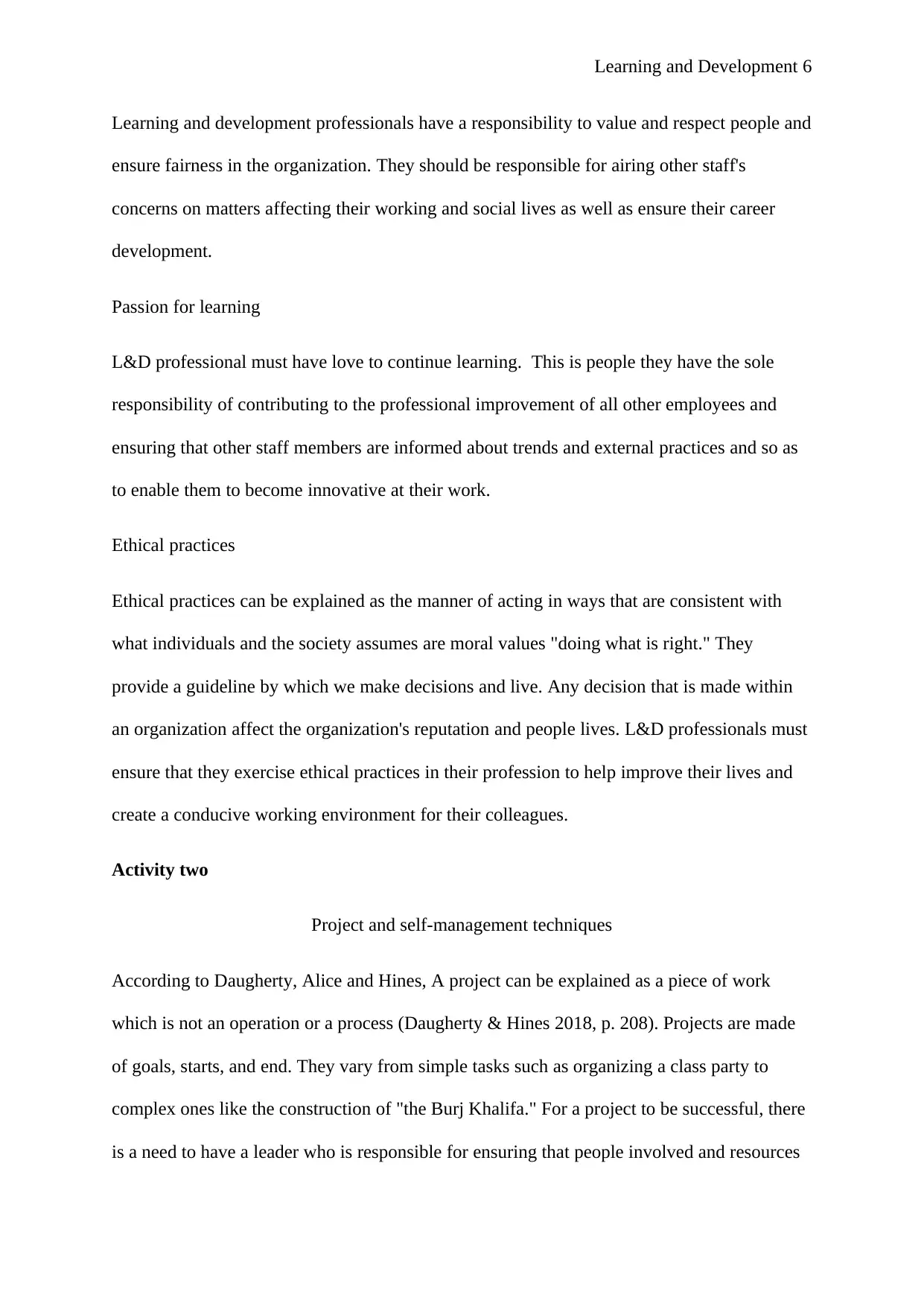
Learning and Development 6
Learning and development professionals have a responsibility to value and respect people and
ensure fairness in the organization. They should be responsible for airing other staff's
concerns on matters affecting their working and social lives as well as ensure their career
development.
Passion for learning
L&D professional must have love to continue learning. This is people they have the sole
responsibility of contributing to the professional improvement of all other employees and
ensuring that other staff members are informed about trends and external practices and so as
to enable them to become innovative at their work.
Ethical practices
Ethical practices can be explained as the manner of acting in ways that are consistent with
what individuals and the society assumes are moral values "doing what is right." They
provide a guideline by which we make decisions and live. Any decision that is made within
an organization affect the organization's reputation and people lives. L&D professionals must
ensure that they exercise ethical practices in their profession to help improve their lives and
create a conducive working environment for their colleagues.
Activity two
Project and self-management techniques
According to Daugherty, Alice and Hines, A project can be explained as a piece of work
which is not an operation or a process (Daugherty & Hines 2018, p. 208). Projects are made
of goals, starts, and end. They vary from simple tasks such as organizing a class party to
complex ones like the construction of "the Burj Khalifa." For a project to be successful, there
is a need to have a leader who is responsible for ensuring that people involved and resources
Learning and development professionals have a responsibility to value and respect people and
ensure fairness in the organization. They should be responsible for airing other staff's
concerns on matters affecting their working and social lives as well as ensure their career
development.
Passion for learning
L&D professional must have love to continue learning. This is people they have the sole
responsibility of contributing to the professional improvement of all other employees and
ensuring that other staff members are informed about trends and external practices and so as
to enable them to become innovative at their work.
Ethical practices
Ethical practices can be explained as the manner of acting in ways that are consistent with
what individuals and the society assumes are moral values "doing what is right." They
provide a guideline by which we make decisions and live. Any decision that is made within
an organization affect the organization's reputation and people lives. L&D professionals must
ensure that they exercise ethical practices in their profession to help improve their lives and
create a conducive working environment for their colleagues.
Activity two
Project and self-management techniques
According to Daugherty, Alice and Hines, A project can be explained as a piece of work
which is not an operation or a process (Daugherty & Hines 2018, p. 208). Projects are made
of goals, starts, and end. They vary from simple tasks such as organizing a class party to
complex ones like the construction of "the Burj Khalifa." For a project to be successful, there
is a need to have a leader who is responsible for ensuring that people involved and resources
⊘ This is a preview!⊘
Do you want full access?
Subscribe today to unlock all pages.

Trusted by 1+ million students worldwide
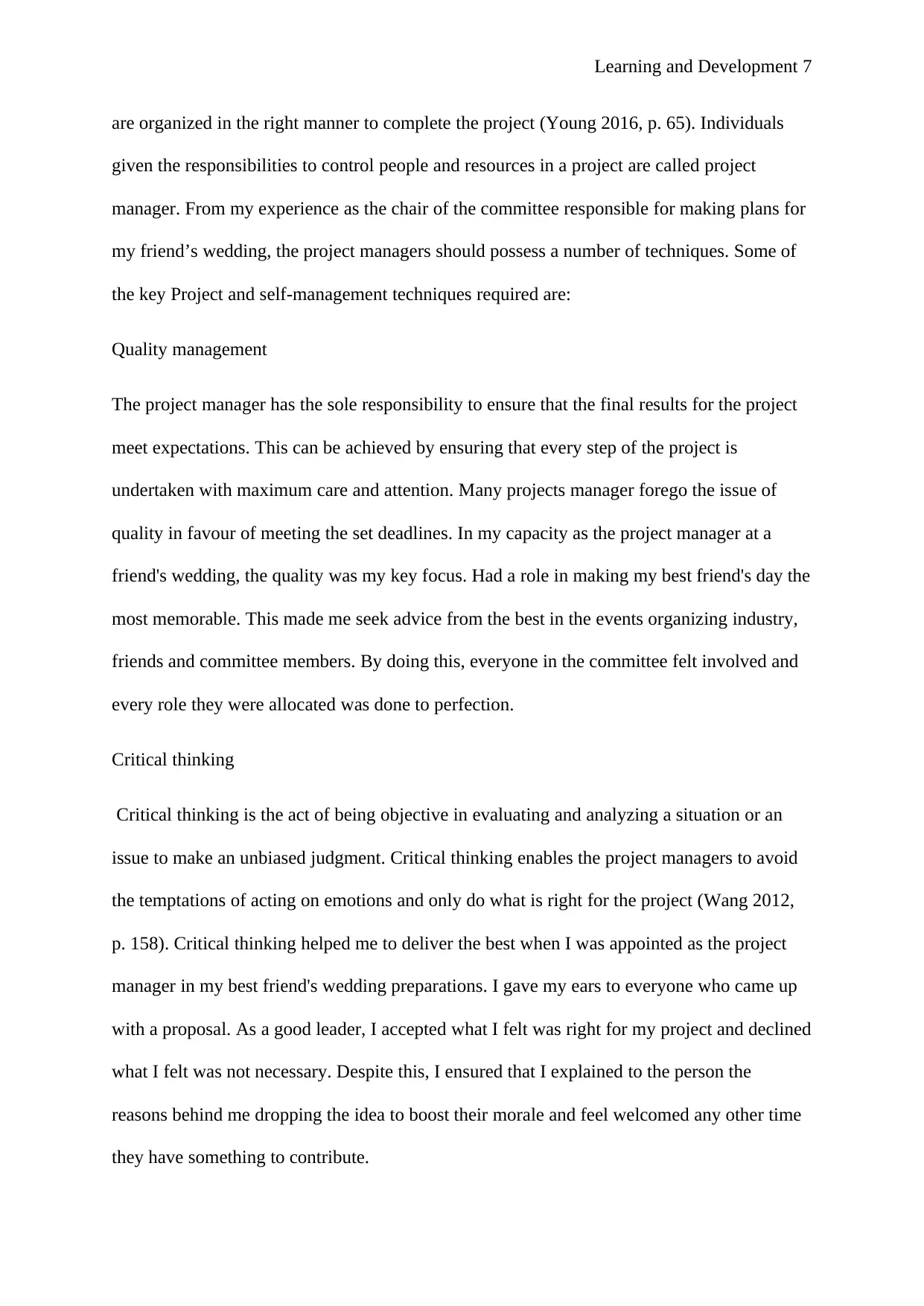
Learning and Development 7
are organized in the right manner to complete the project (Young 2016, p. 65). Individuals
given the responsibilities to control people and resources in a project are called project
manager. From my experience as the chair of the committee responsible for making plans for
my friend’s wedding, the project managers should possess a number of techniques. Some of
the key Project and self-management techniques required are:
Quality management
The project manager has the sole responsibility to ensure that the final results for the project
meet expectations. This can be achieved by ensuring that every step of the project is
undertaken with maximum care and attention. Many projects manager forego the issue of
quality in favour of meeting the set deadlines. In my capacity as the project manager at a
friend's wedding, the quality was my key focus. Had a role in making my best friend's day the
most memorable. This made me seek advice from the best in the events organizing industry,
friends and committee members. By doing this, everyone in the committee felt involved and
every role they were allocated was done to perfection.
Critical thinking
Critical thinking is the act of being objective in evaluating and analyzing a situation or an
issue to make an unbiased judgment. Critical thinking enables the project managers to avoid
the temptations of acting on emotions and only do what is right for the project (Wang 2012,
p. 158). Critical thinking helped me to deliver the best when I was appointed as the project
manager in my best friend's wedding preparations. I gave my ears to everyone who came up
with a proposal. As a good leader, I accepted what I felt was right for my project and declined
what I felt was not necessary. Despite this, I ensured that I explained to the person the
reasons behind me dropping the idea to boost their morale and feel welcomed any other time
they have something to contribute.
are organized in the right manner to complete the project (Young 2016, p. 65). Individuals
given the responsibilities to control people and resources in a project are called project
manager. From my experience as the chair of the committee responsible for making plans for
my friend’s wedding, the project managers should possess a number of techniques. Some of
the key Project and self-management techniques required are:
Quality management
The project manager has the sole responsibility to ensure that the final results for the project
meet expectations. This can be achieved by ensuring that every step of the project is
undertaken with maximum care and attention. Many projects manager forego the issue of
quality in favour of meeting the set deadlines. In my capacity as the project manager at a
friend's wedding, the quality was my key focus. Had a role in making my best friend's day the
most memorable. This made me seek advice from the best in the events organizing industry,
friends and committee members. By doing this, everyone in the committee felt involved and
every role they were allocated was done to perfection.
Critical thinking
Critical thinking is the act of being objective in evaluating and analyzing a situation or an
issue to make an unbiased judgment. Critical thinking enables the project managers to avoid
the temptations of acting on emotions and only do what is right for the project (Wang 2012,
p. 158). Critical thinking helped me to deliver the best when I was appointed as the project
manager in my best friend's wedding preparations. I gave my ears to everyone who came up
with a proposal. As a good leader, I accepted what I felt was right for my project and declined
what I felt was not necessary. Despite this, I ensured that I explained to the person the
reasons behind me dropping the idea to boost their morale and feel welcomed any other time
they have something to contribute.
Paraphrase This Document
Need a fresh take? Get an instant paraphrase of this document with our AI Paraphraser
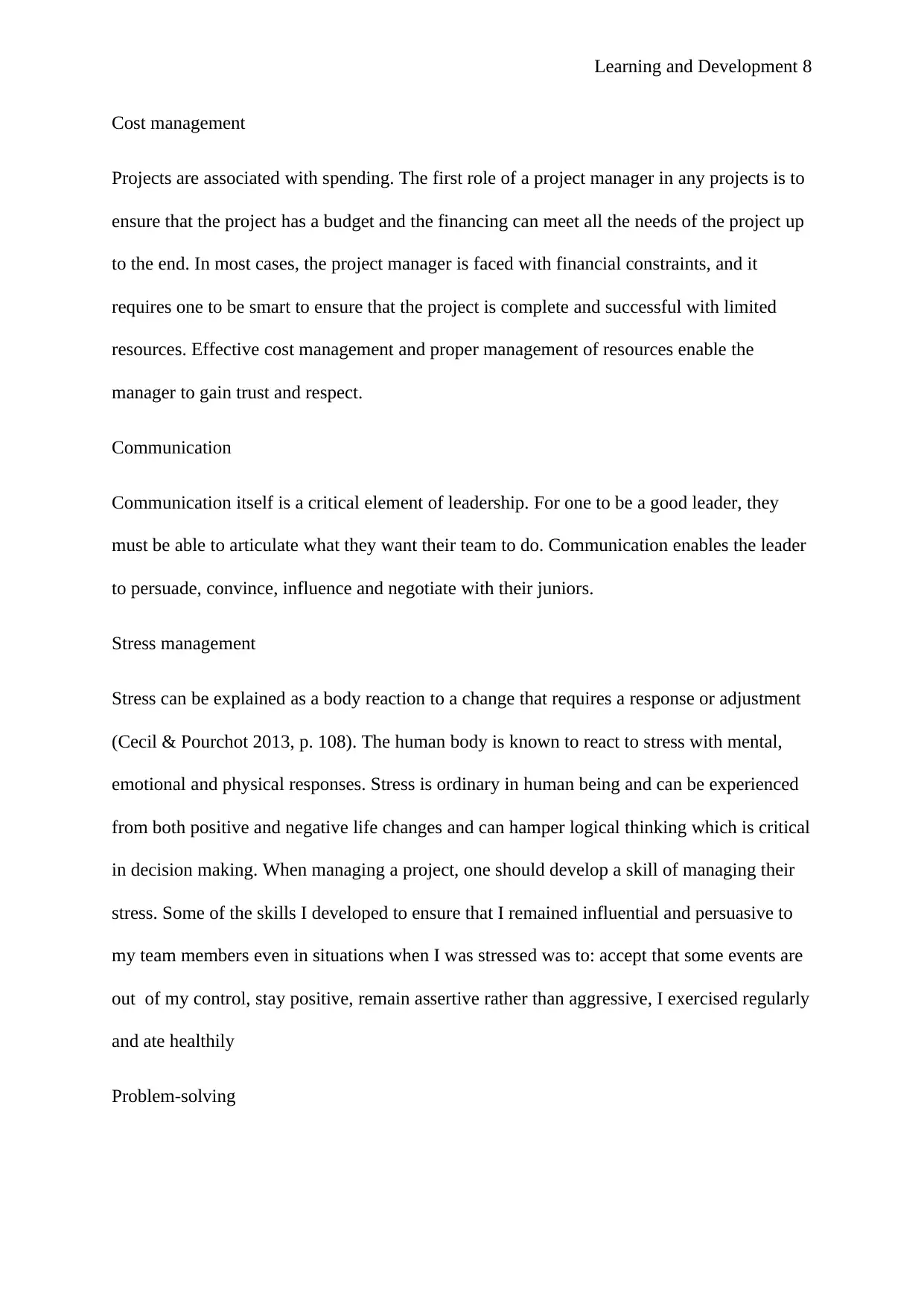
Learning and Development 8
Cost management
Projects are associated with spending. The first role of a project manager in any projects is to
ensure that the project has a budget and the financing can meet all the needs of the project up
to the end. In most cases, the project manager is faced with financial constraints, and it
requires one to be smart to ensure that the project is complete and successful with limited
resources. Effective cost management and proper management of resources enable the
manager to gain trust and respect.
Communication
Communication itself is a critical element of leadership. For one to be a good leader, they
must be able to articulate what they want their team to do. Communication enables the leader
to persuade, convince, influence and negotiate with their juniors.
Stress management
Stress can be explained as a body reaction to a change that requires a response or adjustment
(Cecil & Pourchot 2013, p. 108). The human body is known to react to stress with mental,
emotional and physical responses. Stress is ordinary in human being and can be experienced
from both positive and negative life changes and can hamper logical thinking which is critical
in decision making. When managing a project, one should develop a skill of managing their
stress. Some of the skills I developed to ensure that I remained influential and persuasive to
my team members even in situations when I was stressed was to: accept that some events are
out of my control, stay positive, remain assertive rather than aggressive, I exercised regularly
and ate healthily
Problem-solving
Cost management
Projects are associated with spending. The first role of a project manager in any projects is to
ensure that the project has a budget and the financing can meet all the needs of the project up
to the end. In most cases, the project manager is faced with financial constraints, and it
requires one to be smart to ensure that the project is complete and successful with limited
resources. Effective cost management and proper management of resources enable the
manager to gain trust and respect.
Communication
Communication itself is a critical element of leadership. For one to be a good leader, they
must be able to articulate what they want their team to do. Communication enables the leader
to persuade, convince, influence and negotiate with their juniors.
Stress management
Stress can be explained as a body reaction to a change that requires a response or adjustment
(Cecil & Pourchot 2013, p. 108). The human body is known to react to stress with mental,
emotional and physical responses. Stress is ordinary in human being and can be experienced
from both positive and negative life changes and can hamper logical thinking which is critical
in decision making. When managing a project, one should develop a skill of managing their
stress. Some of the skills I developed to ensure that I remained influential and persuasive to
my team members even in situations when I was stressed was to: accept that some events are
out of my control, stay positive, remain assertive rather than aggressive, I exercised regularly
and ate healthily
Problem-solving
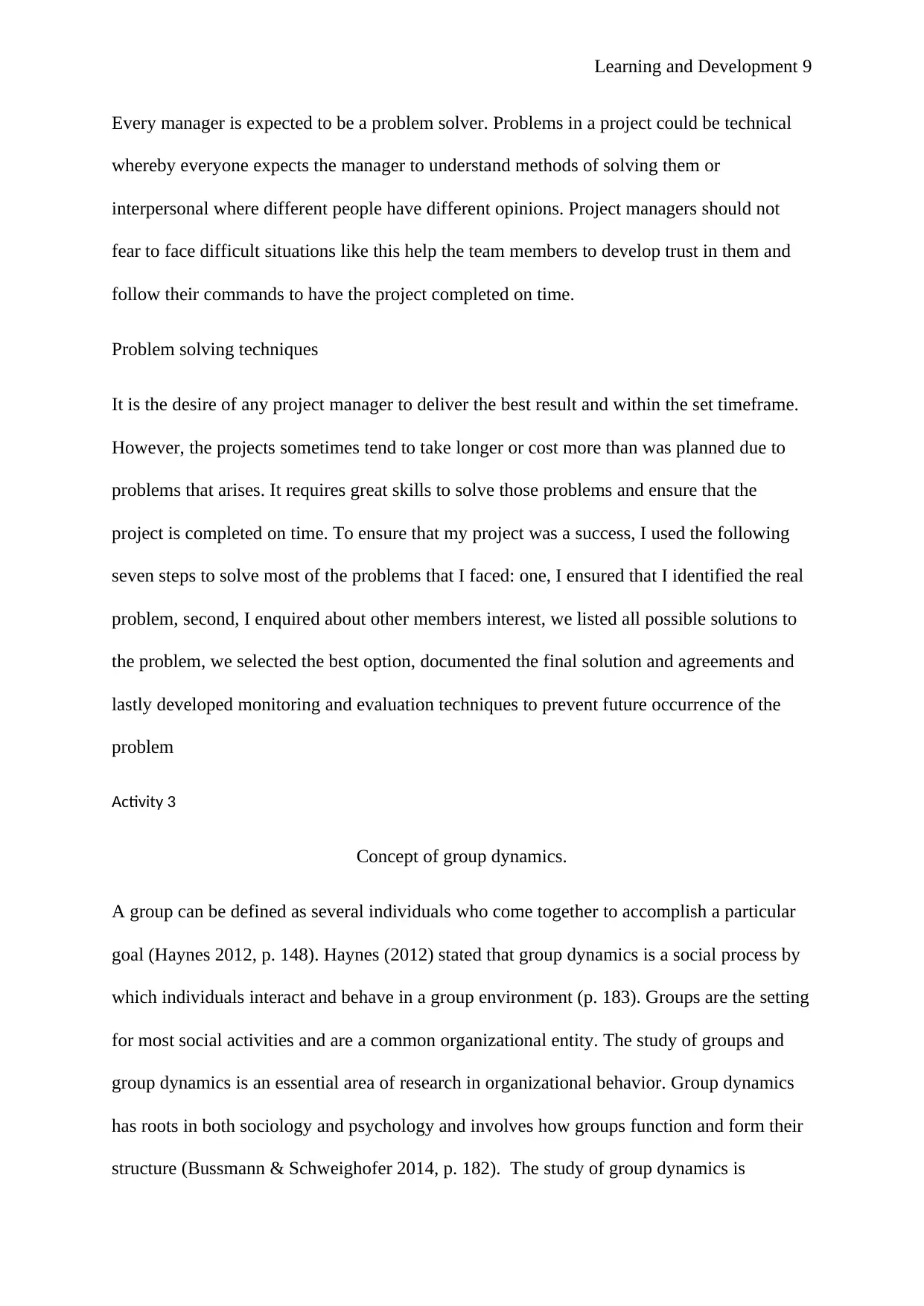
Learning and Development 9
Every manager is expected to be a problem solver. Problems in a project could be technical
whereby everyone expects the manager to understand methods of solving them or
interpersonal where different people have different opinions. Project managers should not
fear to face difficult situations like this help the team members to develop trust in them and
follow their commands to have the project completed on time.
Problem solving techniques
It is the desire of any project manager to deliver the best result and within the set timeframe.
However, the projects sometimes tend to take longer or cost more than was planned due to
problems that arises. It requires great skills to solve those problems and ensure that the
project is completed on time. To ensure that my project was a success, I used the following
seven steps to solve most of the problems that I faced: one, I ensured that I identified the real
problem, second, I enquired about other members interest, we listed all possible solutions to
the problem, we selected the best option, documented the final solution and agreements and
lastly developed monitoring and evaluation techniques to prevent future occurrence of the
problem
Activity 3
Concept of group dynamics.
A group can be defined as several individuals who come together to accomplish a particular
goal (Haynes 2012, p. 148). Haynes (2012) stated that group dynamics is a social process by
which individuals interact and behave in a group environment (p. 183). Groups are the setting
for most social activities and are a common organizational entity. The study of groups and
group dynamics is an essential area of research in organizational behavior. Group dynamics
has roots in both sociology and psychology and involves how groups function and form their
structure (Bussmann & Schweighofer 2014, p. 182). The study of group dynamics is
Every manager is expected to be a problem solver. Problems in a project could be technical
whereby everyone expects the manager to understand methods of solving them or
interpersonal where different people have different opinions. Project managers should not
fear to face difficult situations like this help the team members to develop trust in them and
follow their commands to have the project completed on time.
Problem solving techniques
It is the desire of any project manager to deliver the best result and within the set timeframe.
However, the projects sometimes tend to take longer or cost more than was planned due to
problems that arises. It requires great skills to solve those problems and ensure that the
project is completed on time. To ensure that my project was a success, I used the following
seven steps to solve most of the problems that I faced: one, I ensured that I identified the real
problem, second, I enquired about other members interest, we listed all possible solutions to
the problem, we selected the best option, documented the final solution and agreements and
lastly developed monitoring and evaluation techniques to prevent future occurrence of the
problem
Activity 3
Concept of group dynamics.
A group can be defined as several individuals who come together to accomplish a particular
goal (Haynes 2012, p. 148). Haynes (2012) stated that group dynamics is a social process by
which individuals interact and behave in a group environment (p. 183). Groups are the setting
for most social activities and are a common organizational entity. The study of groups and
group dynamics is an essential area of research in organizational behavior. Group dynamics
has roots in both sociology and psychology and involves how groups function and form their
structure (Bussmann & Schweighofer 2014, p. 182). The study of group dynamics is
⊘ This is a preview!⊘
Do you want full access?
Subscribe today to unlock all pages.

Trusted by 1+ million students worldwide
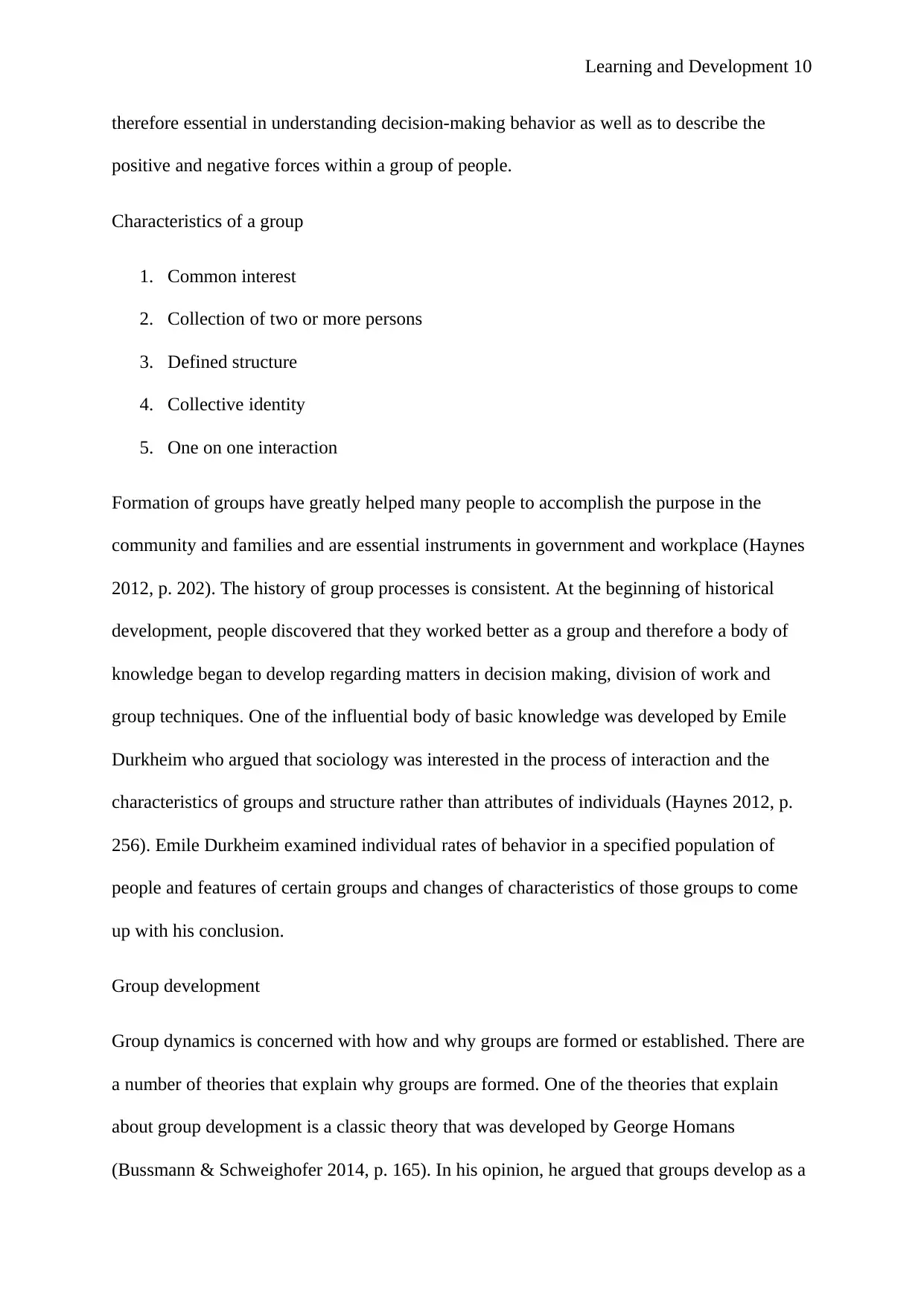
Learning and Development 10
therefore essential in understanding decision-making behavior as well as to describe the
positive and negative forces within a group of people.
Characteristics of a group
1. Common interest
2. Collection of two or more persons
3. Defined structure
4. Collective identity
5. One on one interaction
Formation of groups have greatly helped many people to accomplish the purpose in the
community and families and are essential instruments in government and workplace (Haynes
2012, p. 202). The history of group processes is consistent. At the beginning of historical
development, people discovered that they worked better as a group and therefore a body of
knowledge began to develop regarding matters in decision making, division of work and
group techniques. One of the influential body of basic knowledge was developed by Emile
Durkheim who argued that sociology was interested in the process of interaction and the
characteristics of groups and structure rather than attributes of individuals (Haynes 2012, p.
256). Emile Durkheim examined individual rates of behavior in a specified population of
people and features of certain groups and changes of characteristics of those groups to come
up with his conclusion.
Group development
Group dynamics is concerned with how and why groups are formed or established. There are
a number of theories that explain why groups are formed. One of the theories that explain
about group development is a classic theory that was developed by George Homans
(Bussmann & Schweighofer 2014, p. 165). In his opinion, he argued that groups develop as a
therefore essential in understanding decision-making behavior as well as to describe the
positive and negative forces within a group of people.
Characteristics of a group
1. Common interest
2. Collection of two or more persons
3. Defined structure
4. Collective identity
5. One on one interaction
Formation of groups have greatly helped many people to accomplish the purpose in the
community and families and are essential instruments in government and workplace (Haynes
2012, p. 202). The history of group processes is consistent. At the beginning of historical
development, people discovered that they worked better as a group and therefore a body of
knowledge began to develop regarding matters in decision making, division of work and
group techniques. One of the influential body of basic knowledge was developed by Emile
Durkheim who argued that sociology was interested in the process of interaction and the
characteristics of groups and structure rather than attributes of individuals (Haynes 2012, p.
256). Emile Durkheim examined individual rates of behavior in a specified population of
people and features of certain groups and changes of characteristics of those groups to come
up with his conclusion.
Group development
Group dynamics is concerned with how and why groups are formed or established. There are
a number of theories that explain why groups are formed. One of the theories that explain
about group development is a classic theory that was developed by George Homans
(Bussmann & Schweighofer 2014, p. 165). In his opinion, he argued that groups develop as a
Paraphrase This Document
Need a fresh take? Get an instant paraphrase of this document with our AI Paraphraser
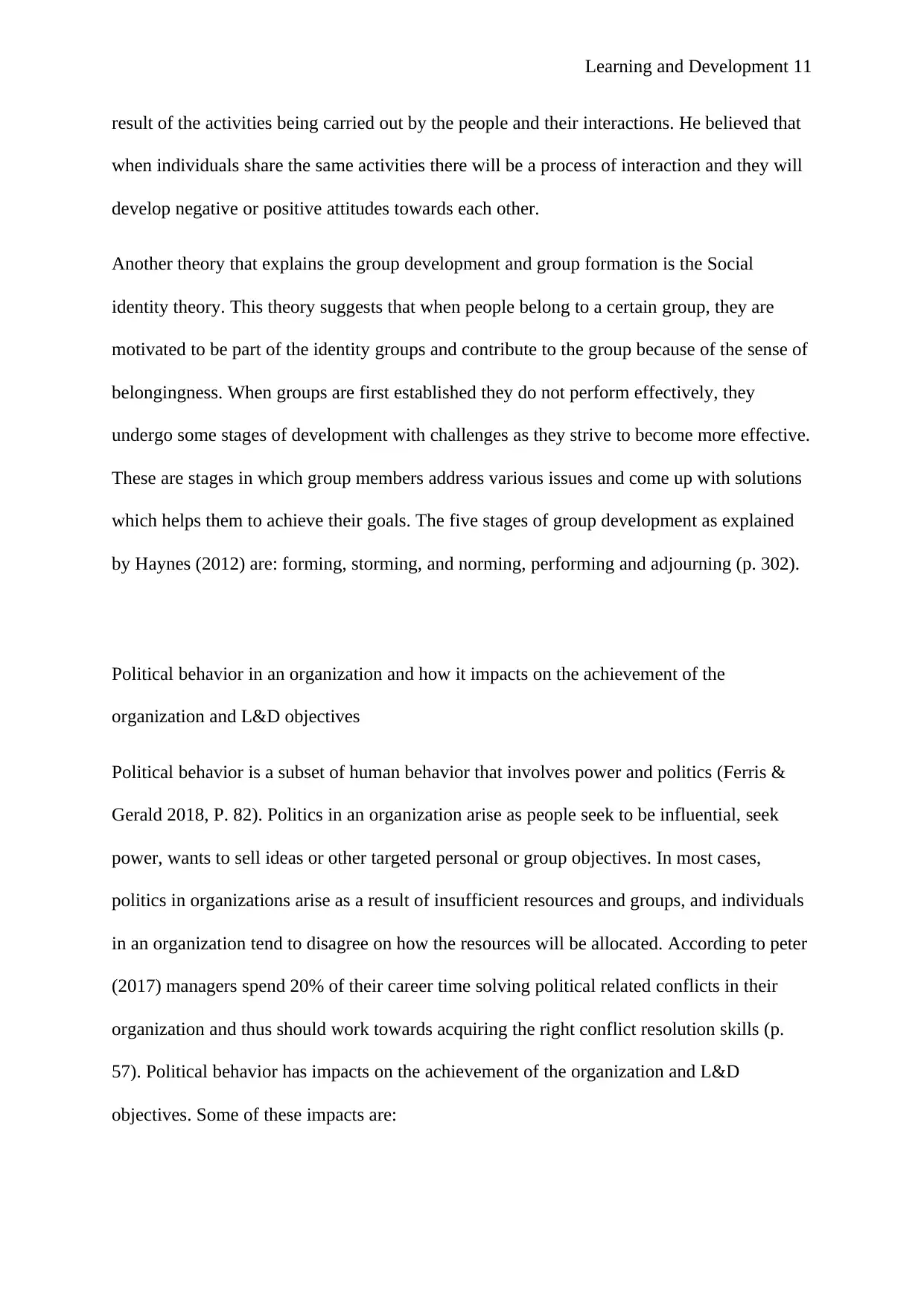
Learning and Development 11
result of the activities being carried out by the people and their interactions. He believed that
when individuals share the same activities there will be a process of interaction and they will
develop negative or positive attitudes towards each other.
Another theory that explains the group development and group formation is the Social
identity theory. This theory suggests that when people belong to a certain group, they are
motivated to be part of the identity groups and contribute to the group because of the sense of
belongingness. When groups are first established they do not perform effectively, they
undergo some stages of development with challenges as they strive to become more effective.
These are stages in which group members address various issues and come up with solutions
which helps them to achieve their goals. The five stages of group development as explained
by Haynes (2012) are: forming, storming, and norming, performing and adjourning (p. 302).
Political behavior in an organization and how it impacts on the achievement of the
organization and L&D objectives
Political behavior is a subset of human behavior that involves power and politics (Ferris &
Gerald 2018, P. 82). Politics in an organization arise as people seek to be influential, seek
power, wants to sell ideas or other targeted personal or group objectives. In most cases,
politics in organizations arise as a result of insufficient resources and groups, and individuals
in an organization tend to disagree on how the resources will be allocated. According to peter
(2017) managers spend 20% of their career time solving political related conflicts in their
organization and thus should work towards acquiring the right conflict resolution skills (p.
57). Political behavior has impacts on the achievement of the organization and L&D
objectives. Some of these impacts are:
result of the activities being carried out by the people and their interactions. He believed that
when individuals share the same activities there will be a process of interaction and they will
develop negative or positive attitudes towards each other.
Another theory that explains the group development and group formation is the Social
identity theory. This theory suggests that when people belong to a certain group, they are
motivated to be part of the identity groups and contribute to the group because of the sense of
belongingness. When groups are first established they do not perform effectively, they
undergo some stages of development with challenges as they strive to become more effective.
These are stages in which group members address various issues and come up with solutions
which helps them to achieve their goals. The five stages of group development as explained
by Haynes (2012) are: forming, storming, and norming, performing and adjourning (p. 302).
Political behavior in an organization and how it impacts on the achievement of the
organization and L&D objectives
Political behavior is a subset of human behavior that involves power and politics (Ferris &
Gerald 2018, P. 82). Politics in an organization arise as people seek to be influential, seek
power, wants to sell ideas or other targeted personal or group objectives. In most cases,
politics in organizations arise as a result of insufficient resources and groups, and individuals
in an organization tend to disagree on how the resources will be allocated. According to peter
(2017) managers spend 20% of their career time solving political related conflicts in their
organization and thus should work towards acquiring the right conflict resolution skills (p.
57). Political behavior has impacts on the achievement of the organization and L&D
objectives. Some of these impacts are:
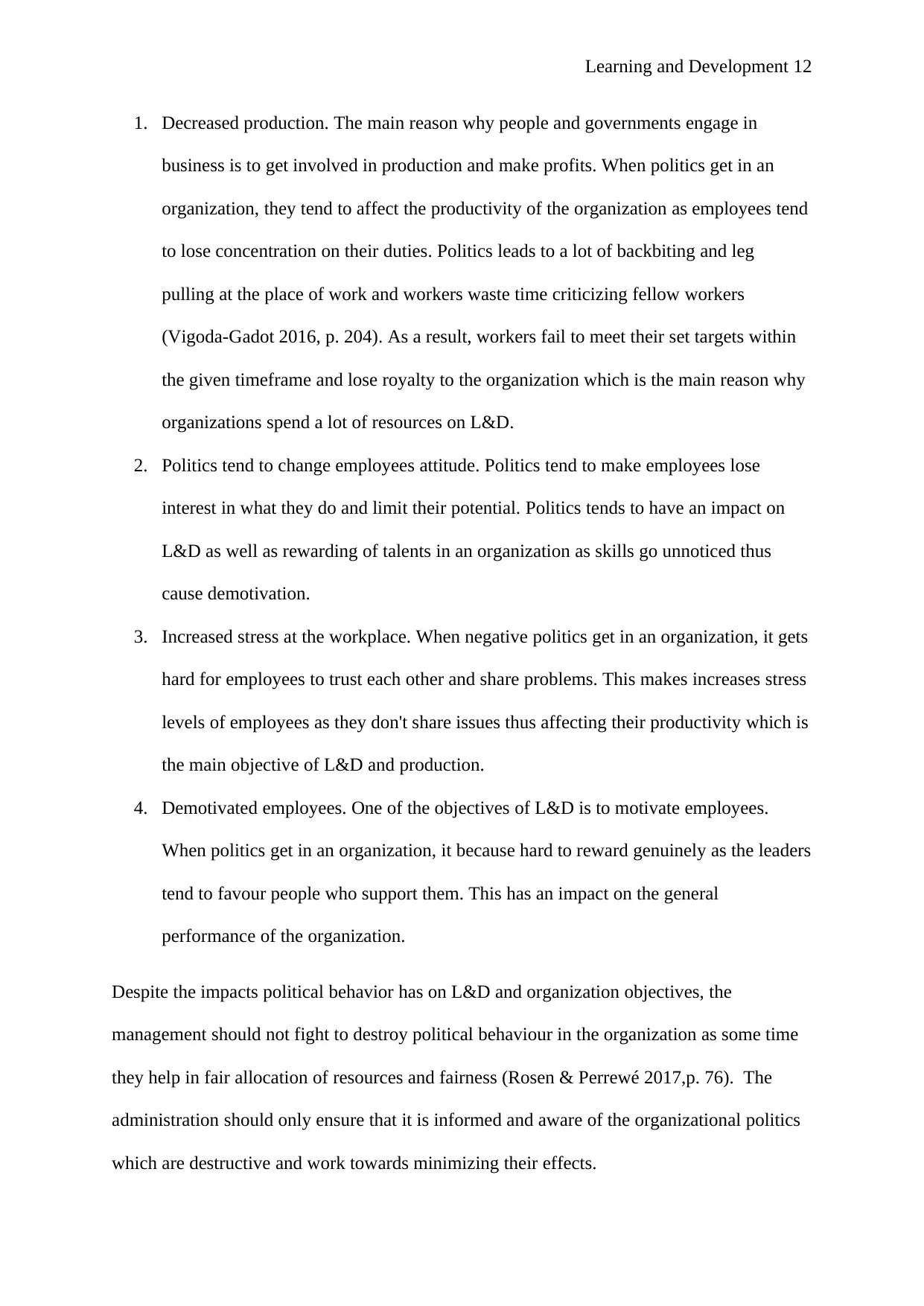
Learning and Development 12
1. Decreased production. The main reason why people and governments engage in
business is to get involved in production and make profits. When politics get in an
organization, they tend to affect the productivity of the organization as employees tend
to lose concentration on their duties. Politics leads to a lot of backbiting and leg
pulling at the place of work and workers waste time criticizing fellow workers
(Vigoda-Gadot 2016, p. 204). As a result, workers fail to meet their set targets within
the given timeframe and lose royalty to the organization which is the main reason why
organizations spend a lot of resources on L&D.
2. Politics tend to change employees attitude. Politics tend to make employees lose
interest in what they do and limit their potential. Politics tends to have an impact on
L&D as well as rewarding of talents in an organization as skills go unnoticed thus
cause demotivation.
3. Increased stress at the workplace. When negative politics get in an organization, it gets
hard for employees to trust each other and share problems. This makes increases stress
levels of employees as they don't share issues thus affecting their productivity which is
the main objective of L&D and production.
4. Demotivated employees. One of the objectives of L&D is to motivate employees.
When politics get in an organization, it because hard to reward genuinely as the leaders
tend to favour people who support them. This has an impact on the general
performance of the organization.
Despite the impacts political behavior has on L&D and organization objectives, the
management should not fight to destroy political behaviour in the organization as some time
they help in fair allocation of resources and fairness (Rosen & Perrewé 2017,p. 76). The
administration should only ensure that it is informed and aware of the organizational politics
which are destructive and work towards minimizing their effects.
1. Decreased production. The main reason why people and governments engage in
business is to get involved in production and make profits. When politics get in an
organization, they tend to affect the productivity of the organization as employees tend
to lose concentration on their duties. Politics leads to a lot of backbiting and leg
pulling at the place of work and workers waste time criticizing fellow workers
(Vigoda-Gadot 2016, p. 204). As a result, workers fail to meet their set targets within
the given timeframe and lose royalty to the organization which is the main reason why
organizations spend a lot of resources on L&D.
2. Politics tend to change employees attitude. Politics tend to make employees lose
interest in what they do and limit their potential. Politics tends to have an impact on
L&D as well as rewarding of talents in an organization as skills go unnoticed thus
cause demotivation.
3. Increased stress at the workplace. When negative politics get in an organization, it gets
hard for employees to trust each other and share problems. This makes increases stress
levels of employees as they don't share issues thus affecting their productivity which is
the main objective of L&D and production.
4. Demotivated employees. One of the objectives of L&D is to motivate employees.
When politics get in an organization, it because hard to reward genuinely as the leaders
tend to favour people who support them. This has an impact on the general
performance of the organization.
Despite the impacts political behavior has on L&D and organization objectives, the
management should not fight to destroy political behaviour in the organization as some time
they help in fair allocation of resources and fairness (Rosen & Perrewé 2017,p. 76). The
administration should only ensure that it is informed and aware of the organizational politics
which are destructive and work towards minimizing their effects.
⊘ This is a preview!⊘
Do you want full access?
Subscribe today to unlock all pages.

Trusted by 1+ million students worldwide
1 out of 19